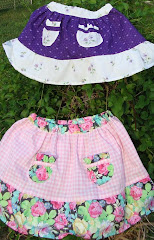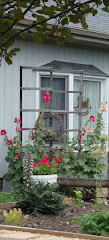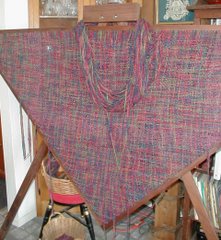
Lots of activities this week along with the usual gardening and general chores meant not much time for cooking. But when it's hot we tend to prefer lighter meals anyway. Last night's meal fit that profile with a combination of garden vegetables and a bit of local cheese.
Yesterday morning I prepared Harvey House Slaw (recipe below) using a head of cabbage and several Egyptian onions from our garden. It's best when made at least 4 hours ahead of serving and any leftovers will keep for several weeks in the fridge. I think it gets better the longer the vegetables marinate and have seen similar recipes with names such as '6-weeks Slaw.' The onions lose quite a bit of their edge in the slaw so don't feel like you have to start with a sweet onion.
Earlier in the week I cut the crust from the last of a loaf of wholegrain bread (from local wheat) I'd baked in my pullman pan. Then thinly sliced it and baked the slices in a very low oven till dried and crispy -- making homemade melba toast. I do this regularly with extra bread so I almost always have a tin of crisp melba toast sitting on the shelf. We use it in place of crackers much of the time and since I planned to serve a cheese spread for last night's meal, the melba toast was a perfect accompaniment.
A friend and I had been talking about cheese spreads lately and when I went to town in the middle of the week I couldn't resist picking up a small tub of a locally-produced goat cheese and dried tomato spread. I love this spread and hope one of these days we can make our own version -- DH is slowly coming 'round to the idea of a couple of dairy goats and this cheese on a crisp toast makes a great selling point.
To go with the slaw, cheese, and toasts, DH picked a mess of green beans (third one this week from the garden!) which I lightly steamed and then sprinkled with coarse salt. Sometimes I'll dribble a little olive oil over the beans but since the Harvey House has a vinegar and oil dressing another oil didn't seem necessary.
We're still eating sweet cherries my sister picked and tho we've added cherries to a few yogurt smoothies and canned or frozen most of them, we enjoy them best by the handful. Yes, spitting out cherry pits as we go. That's how we ate them last night sitting on the back deck watching a faraway neighbor's fireworks. Relaxing end to a busy week.
Harvey House Slaw
1 head of cabbage, cored
1 large onion, thinly sliced
1-1/3 cup sugar or 2/3 cup honey
1 cup vinegar (I use apple cider vinegar)
1/2 cup salad oil (I use sunflower oil)
2 teaspoons dry mustard
1 teaspoon celery seed
2 teaspoons salt

Cut cabbage into wedges and then thinly slice. (Alternatively, may use food processor to slice.) Put cabbage in a large bowl and scatter onion slices on top. If using sugar, pour over onion.
Put remaining ingredients (and honey if using rather than sugar) in medium saucepan and bring to a rolling boil. Stir to dissolve honey and pour over cabbage immediately. Cover with lid or plastic wrap to hold in steam. Do not stir cabbage mixture at this time. Refrigerate at least 4 hours before serving. Stir prior to serving.

















